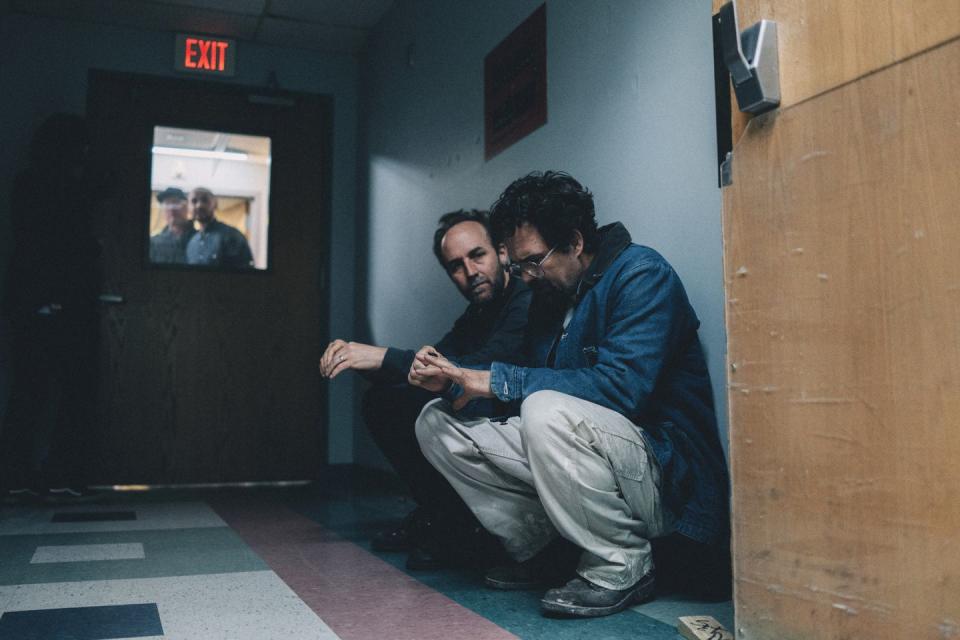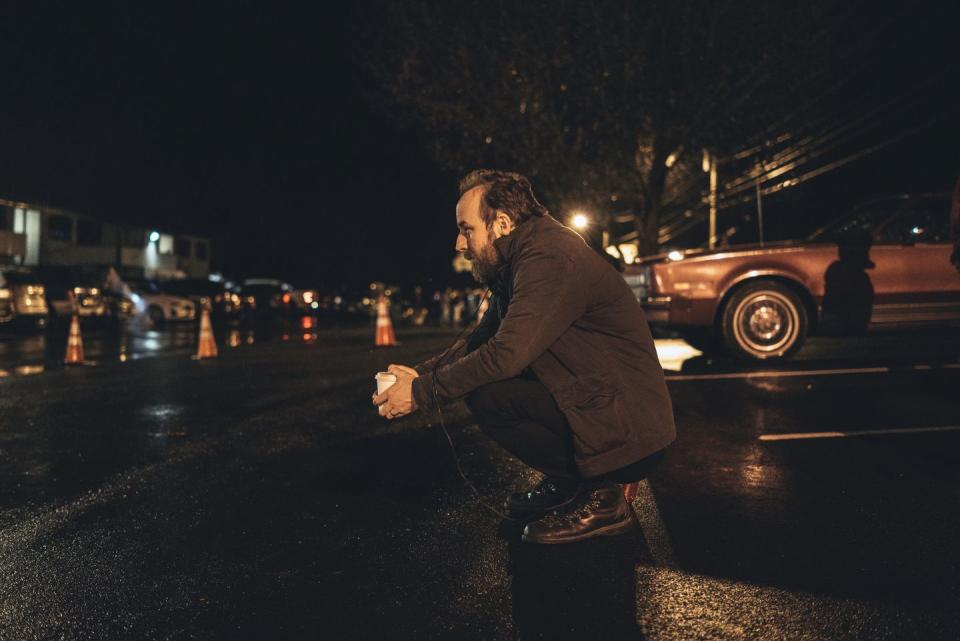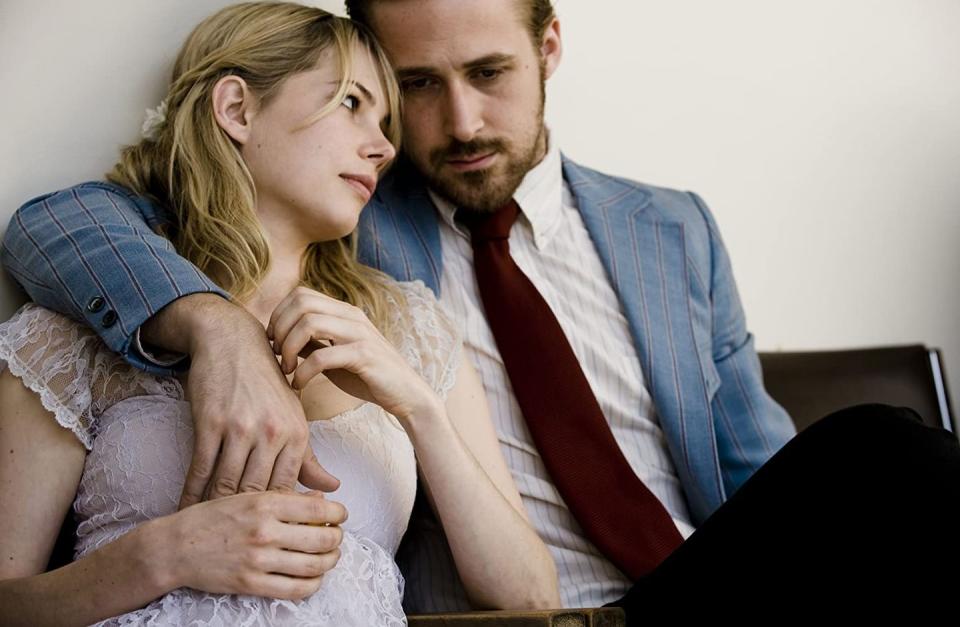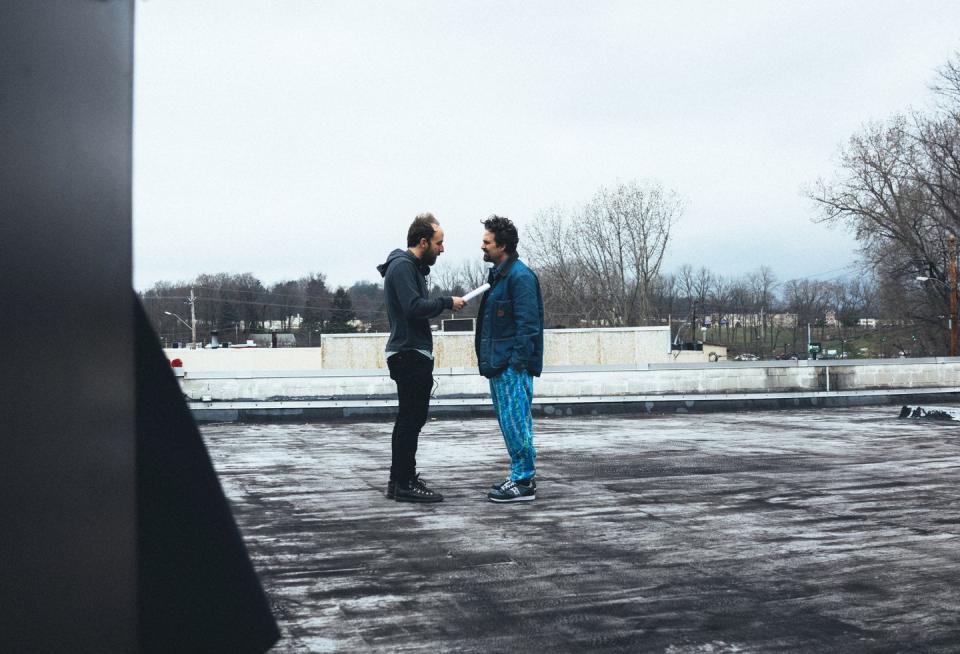'I Know This Much Is True' Is 2020's Most Painful Show. Its Director Has No Regrets.

Derek Cianfrance loves Mark Ruffalo’s face. He loves that his face lacks symmetry and isn’t classically “beautiful.” That the left side of his face and the right side of his face aren’t quite in sync—not since Mark Ruffalo suffered a brain tumor when he was 34—that each side still, sometimes, betrays its brother. Derek Cianfrance especially loves Mark Ruffalo’s teeth. That they are not movie star teeth. They have chips in them; they have not been straightened. Derek Cianfrance hates pearly white perfect straight teeth that are too perfect and white and seem fake. So when he films Mark Ruffalo’s face, Derek Cianfrance always uses a long lens to show more of this imperfection—because this imperfection represents everything it means to be real and human and so actually beautiful. Such is the face of Mark Ruffalo.
Mark Ruffalo’s face appears now before Derek Cianfrance. The director is seated in his Brooklyn basement, editing his HBO show, I Know This Much Is True. And then: another Mark Ruffalo, two Mark Ruffalo faces, now side by side on the same screen. Mark Ruffalo is playing twins, Dominick and Thomas, Dominick a divorced housepainter, Thomas a paranoid schizophrenic.
Both twins, both Mark Ruffalos, are in pain, but the pain looks different on each face. For Dominick’s pain, Derek Cianfrance wanted Mark Ruffalo to be tired and agitated, and so he had Mark Ruffalo do 50 pushups right before shooting, so that he would seem breathy and taxed and a little aggressive when answering a phone or climbing a ladder. For Thomas, he wanted the pain to be even more physical. So Mark Ruffalo gained 30 pounds and hunched over a lot. And then Derek Cianfrance decided to open the curtain with pain, and so the very first scene is Mark Ruffalo’s Thomas sitting in a library and sawing off his hand with a knife.
Derek Cianfrance doesn’t yet know what all this pain really means. He’s still editing. He knows only that it is important. He knows he wants to show Mark Ruffalo first from a distance and then from up close. He wants Mark Ruffalo’s bodily pain to draw the viewers in. Then his face will keep them. His imperfection, Derek Cianfrance believes, they too will love.
The critics do not love Derek Cianfrance’s TV show with Mark Ruffalo. The series hasn’t even aired yet and already they are trashing it.
They think the TV show is too heavy and dark and depressing. A parade of misery. The Boston Globe uses the word “orgy,” as in, an orgy of misery. Other critics call it “misery porn,” suffering for the sake of suffering. In short: They fucking hate it. It fucking bums them out.
Cianfrance tries not to read the reviews, though sometimes a friend will send him a really bad one, which makes Cianfrance laugh because of how bad it is. But bad reviews also make him sad because he’s worked so hard on this film. He stopped production in March (“pandemic lurking and looming”), broke down his editing facility in Brooklyn and sent everyone home.
For two months, he’s been editing in his basement, coming up occasionally for sardines or beans. Sixteen hours a day, zooming a dozen other editors, sending work to some two hundred VFX artists. He was doing AVR recording with Ruffalo while the actor huddled under blankets with his computer, hoping to contain the sound, and downloading the audio files at night, his own computer chugging away.

And Cianfrance still hasn’t finished editing the show. Yet, still, here come the reviews: We don’t need something so depressing, they say, not now during these times. But that’s just a crock of shit, Cianfrance thinks. It’s not gratuitous and sad. It’s human.
They’ve said it before, the critics. Blue Valentine, Cianfrance’s first major picture, was so depressing it took him 12 years to convince a studio to make it. It’s about a marriage falling apart after a child is born. But everyone loved that movie in the end. And Place Beyond the Pines, his second major film: also tragic, also loved.
But, the critics say, nothing is quite as heavy and depressing and tragic as I Know This Much Is True, which is just really unnecessarily, gratuitously heavy and depressing and tragic. Cianfrance went too far, they say. This time, there was too much pain.
Here’s a scene ...
Dominick sits on his couch and reads his grandfather’s translated memoir. His grandfather, he learns, emigrated from Italy, indirectly caused his brother’s death, drowned his brother’s pet monkey. Then, he bought, raped, and impregnated Dominick’s grandmother, the daughter of whom (Dominick’s mom) he also potentially raped (the consequence, Dominik believes, being him). He picks his head up from the manuscript to see televised news flashes of Kuwaiti oil fields ablaze. Then he answers the phone to learn that Thomas has been serially raped in psychiatric confinement and needs to get tested for HIV.
Sure, maybe that’s some heavy shit.
But the criticism—that’s still a crock of shit! It’s not the critic’s job to be the cultural watchdog for people, Cianfrance thinks. Like hey, watch out, this is tough for you. Life is tough. Having a heart is tough.
And besides, read the novel. Here's a line: “Life was a whoopee cushion, a chair yanked away just as you were having a seat. What was the old Army song? We’re here because we’re here because we’re here because we’re here.” Yeah, sure, maybe that's some heavy shit too. But did they think Cianfrance was just going to adapt this novel like mental health and trauma and suffering are no big deal? Did they think he wasn’t going to show all of it?
Well, who wants to watch all of it? they ask. Who should have to endure that? Everyone, Cianfrance thinks. Everyone.
Derek Cianfrance had two recurring nightmares as a child: nuclear war and his parents getting a divorce—which, for a child, are basically the same thing.
Home was Colorado. Lower middle class suburbia with a perfect front lawn and perfect smiling family photos in the hall: mom, dad, Derek, brother, baby sister. But there were also confrontations and shouting at the dinner table and arguments through walls. These things confused Cianfrance; they were “the facade of happiness, the facade of perfection.” To protest, he stopped smiling in photos. He still doesn’t really smile in photos or have social media, which is also a facade, he thinks. (“Look how great my dinner is. Look at this fucking awesome restaurant I'm at. Look at my friends, how beautiful my friends are. Look at the club I'm in. I'm in the hottest spot in town.”) Lies.
The more traumatic moments he called “24-frame memories,” experiences condensed into brief images, like flashes of film. One was playing pinball as a kid and hearing his friend’s parents drunkenly beating each other. Another was church, which the Cianfrances attended weekly. (“Talk about heavy shit: Jesus Christ on the cross is a heavy image. Or how about the pieta? I'd catch a glimpse of the pieta as an eight year old boy. It was just like a horror movie.”)

But the art and images of suffering also fascinated Cianfrance. He started taking pictures: his brother with tears streaming down his face, shrieking at their mother standing there with her nightgown and curlers in her hair; his dad changing a tire in the Arizona desert as cars shot past at 75 miles and hour, screaming, “put the fucking camera away!” Truths.
When Cianfrance watched John Cassavetes’s Faces (about an eroding marriage) as a film student at the University of Colorado Boulder, he thought: now this is a real story. His first film gig was to shoot a wedding. He went full Cassavetees on that wedding. He put the camera on debauchery, guests getting drunk and being sloppy. (“It was raw.”) The bride and groom hated it. His first critics.
When Cianfrance was 20, the nuclear event finally happened: his parents got divorced. He started writing Blue Valentine then as a warning to himself, a cautionary tale not to repeat the mistakes of his parents. But no one wanted to make the movie. Ten years went by. Cianfrance got married.
He wrote to his dad: “I could never be a father. I can’t find myself being so selfless.” Cianfrance was 30 then. Nine months later, Walker was born.
If the nuclear blast of divorce scared him as a child, the fear of passing trauma down to future children terrified him as an adult. He remembered when his parents brought home his baby sister, Megan, from the hospital. Megan was a jewel, a precious thing for the family and the neighborhood. But also something fragile, something that could be broken, and Cianfrance also feared Megan was in danger, because Megan was the person who always brought others happiness, and that gift takes such a herculean effort, when your family isn't always happy.
Cianfrance's fear for his own child was both an epigenetic fear—that somehow, his children would inherit a destructive, unhappy gene—and an artistic fear: having kids would make him a worse filmmaker.
But Cianfrance was wrong. He was able to finish (and get financed) Blue Valentine only after having children. The film is about legacy. All his films are. But having kids all of a sudden put legacy into perspective: he was no longer simply the child of divorce, he realized. He was the father.

What about his own legacy of divorce? How could he break that cycle, tear down the facades? Talk. Tell the truth. But the truth wasn't easy.
When Walker was three, the family took a trip to the museum where they saw mummies. That night before bed, Walker couldn’t sleep.
“What was that?” he asked his dad.
“Well, it’s a person who died and they preserved the body,” Cianfrance said.
“What do you mean? ... There’s a person in there?”
“Yeah.”
“What happens when you die?”
“Well, you stop moving.”
“Am I gonna stop moving someday?”
“Yeah, you are. But we all do.”
Walker was confused.
“What do you mean I'm not going to move?”
“Well ...”
Then Cianfrance just started talking—about reincarnation and transcendence and every other theory of death he knew. He was about to quote Shakespeare (“some believe you’re just food for worms.”) when he stopped, looking at a sleepless Walker.
“You know what happens when you die?” Cianfrance asked, finally. “You go to Heaven. And Heaven is the most beautiful place. It’s like being on vacation. It’s really sunny all the time. And the great thing about Heaven is everybody who’s ever died is there. And you can see them.”
“Oh, okay,” said Walker, relieved.
And the boy went to sleep.
That was a facade, wasn’t it? To prevent the mummies from being a 24-frame memory, Cianfrance had told a facade, a photo with perfect teeth. It’s maybe the only story he’s ever told with an unconditionally happy ending.
Betrayal? Lies? Maybe. Or maybe some facades must wait to be dismantled.
Derek Cianfrance has just finished shooting I Know This Much Is True. It’s early morning, October, 2019. He steps outside his apartment to call his therapist. He hired the therapist to be closer to his character, Dominick, who sees a therapist throughout the show, but really Cianfrance hired a therapist because, well, he probably just needed a therapist anyway.
Before he can say anything to his therapist, Cianfrance gets a call from his mom in Colorado, which he senses is urgent. He tells his therapist he has to go. His mom delivers the news, another 24-frame memory, the most difficult thing Cianfrance has ever heard: his sister, Megan, has died in her sleep. Cianfrance walks back inside, sits down at his table, and cries.
He had spent a lot of time talking to Ruffalo about therapy and family and siblings. Ruffalo’s brother, Scott, was shot and killed in 2008, and Cianfrance suspects that Ruffalo became so obsessed with I Know This Much Is True because of his brother. Cianfrance knew he wanted to make I Know This Much Is True because of his sister. Megan ran an assisted living facility for the elderly, but she had a hard time taking care of herself. She’d push her kids into the doctor’s office, but rarely went herself. (“Megan needed a Megan.”) Megan was Dominick and Dominick was Megan: taking care of others, while suffering. And now Cianfrance is Dominick and Ruffalo too, because Cianfrance is here and his sibling is gone forever.

The first scene of Blue Valentine finds a little girl calling out for her missing dog: “Megan! Megan!” You communicate with people you love through your work, Cianfrance believes. You have conversations you can’t have in real life. Cianfrance often mixes up his words and repeats things and talks in circles. Movies make it easier to have conversations.
Months pass. Cianfrance stays in his basement editing for 16 hours. Zooming Ruffalo. Eating beans. The reviews come in. The critics fucking hate it. Cianfrance keeps editing. He’s beginning to understand a bit better what his show is really about, what all this pain is really for. Even if it will take critics some time.
Grieving and editing a show about grief—it’s cathartic, Cianfrance realizes. And he feels closer to his sister through this grief, this pain. His mother calls. She breaks down crying, saying “I’m sorry, I’m really getting better,” but Cianfrance just says you don’t need to stop crying to feel better. Pain is okay. Crying is okay. Didn’t the Greeks invent tragedy to cry and feel better? Isn’t that what tragedy is? The Dionysia in Athens. Three days of festivals devoted to heavy, depressing shit. (“It’s purging of emotion through pity and fear. It's catharsis. It's epiphany. That's what it means to be truly alive.”)
Cianfrance lets friends watch rough cuts of his show: the criticism he really cares about. He asks one, a father who had lost his son, “What did you think? Was it dark enough?”
The man replies: “It should have been darker.”
Derek Cianfrance is not a pessimistic man. He makes movies to feel less alone. He makes movies so that people who don’t live perfect smiling, happy-ever-after lives can feel less alone. He is making I Know This Much Is True, he realizes, for those who look after others, those who refuse to let others feel alone. It’s so that these caretakers know their pain is shared; they are not alone either.
If you have loved someone, you have lost someone, Cianfrance believes. And if you haven’t yet lost, you will. And then what will you do? You will watch tragedy. And you need art for that, don’t you? You need a story.
What does Derek Cianfrance say to Walker, now 16, after he tells him Aunt Megan has died? What’s the story he tells all these years later, the story that’s really true and not just a facade? He says: “We live on in our memories through people. You can touch people for generations and generations and generations. That's eternity, that's Heaven. It is the ability to leave a positive mark on the world.”
To leave this mark, we need to look after each other, Cianfrance believes. We need to be each other’s keepers, each other’s Dominicks, each other’s Megans. Isn’t that more relevant now in these times than ever? Doesn’t a pandemic actually just make the pain in I Know This Much Is True more necessary, more true?
Heavy shit. Yeah, maybe it’s a little heavy and watching a beautiful face in pain is tough. Life is tough. Having a heart is tough. We endure it anyway. And we should endure it. We need to endure it.
Why?
Because we’re here because we’re here because we’re here.
Derek Cianfrance goes back to editing. His screen is filled with Mark Rufallo’s faces. He has two weeks to finish.
You Might Also Like

